Flow forming is an excellent method for forming nickel-cobalt-based super alloys, stainless steels, aluminum, brass, tantalum, columbium, titanium, and other heat-resistant steels. Flow forming produces parts that are cylindrical, conical, or contoured with precise control of desired wall thicknesses.
Flow forming Process
There are three distinct processes to achieve the part's final profile or shape:
- Forward axial flow forming
- Reverse axial flow forming
- Shear forming
Each of these processes can use a one, two, three, or four roller configuration based on the part profile and starting wall thickness.
Features
The unique features of the flow forming process allow for innovative, cost-effective engineering or redesign of your product or part, resulting in the following features:
- Traditional multi-piece designs can be formed as a single, seamless piece
- Increase mechanical properties, such as tensile/yield strength and hardness
- Provide design versatility to produce a unique seamless profile with varying wall thicknesses
- Produce cylindrical, conical, or contoured shapes up to 47" diameter
- Typical interior finishes of 15Ra without additional manufacturing steps
- High material utilization from near-net shape forming process
What Makes a Component Ideal for Flow Forming?
- Symmetry around a centerline - cones and cylinders (or a combination).
- Final part wall thicknesses between .020 and .200in.
- Diameters between 1 and 24in.
- Length-to-diameter ratios greater than 2.5 to 1.
- Controlled variations in wall thickness, especially where there are heavy bottoms and thinner side walls.
- Difficult-to-form materials, including stainless steel, Hastelloy, Inconel, and other heat-resisting alloys.
- Requirements for various additional manufacturing processes, including machining, welding, or finishing.
- Parts that can benefit from the effects of cold working on the material- increased strength and wear resistance, harder surfaces.
- Tolerances that exceed the capabilities of deep drawing or spinning requiring precision that approaches machined parts.
- Parts that can benefit from design changes to optimize the effectiveness of flow forming - without adversely affecting function.
- Parts capable of carrying a higher overhead than is incurred with simple stamping, sheet-metal bending, or other basic forming operations.
Metal spinning versus flow forming
Flow forming is sometimes referred to as a controlled metal spinning process. A key difference between flow forming and metal spinning is that spinning does not reduce wall thickness of the starting blank; therefore spinning does not hold precise control of contours. Flow forming is based on a calculated reduction of the thickness of a starting blank or preform. The reduction is closely controlled, which results in precise wall thicknesses and accurate profiles of the final part.
Another difference between flow forming and metal spinning is in the stability of the formed part. The typical spinning process heats the preform to provide the required ductility and often distorts the final part during cooling. Flow forming is a cold forming process, which ensures the final part's controlled characteristics are to design with no distortion.
Metal spinning and flow forming are similar processes. In some respects, flow forming can be considered a specialized kind of metal spinning. But the two processes are different, and each is designed to meet different application requirements.
Metal spinning originated as a handcraft technique with origins, according to some, dating back to 10th-century China. Nowadays it is a powerful and advanced manufacturing process carried out by CNC machines.
Today the industrial spinning industry not only uses precision metal spinning, but also a closely related process called flow forming. In fact, flow forming can be considered to be a specialized kind of spinning process.
Both metal spinning and flow forming can make workpieces from just a few inches in diameter up to several feet in diameter and lengths. Flow forming today produces parts for the nuclear, oil and gas, chemical, and medical industries, among others. Metal spinning technology can be found in a broad range of fields, from decorative components and general industrial products to aerospace and defense components (see Figures 1 and 2).
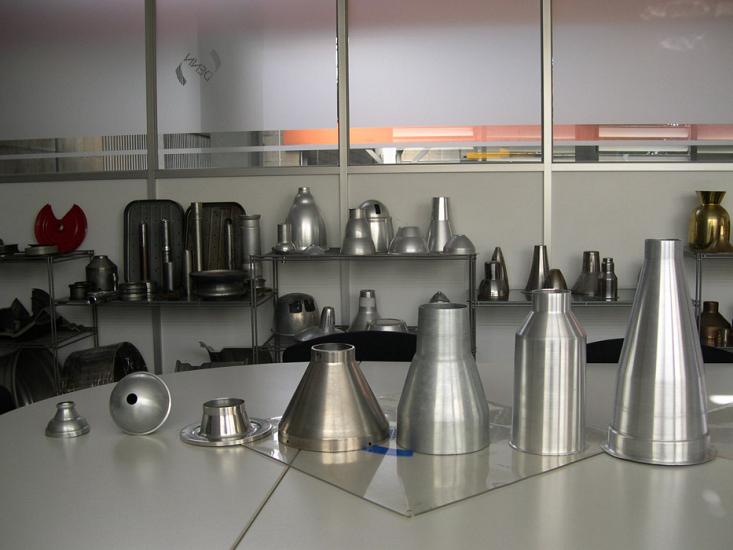
Figure 1
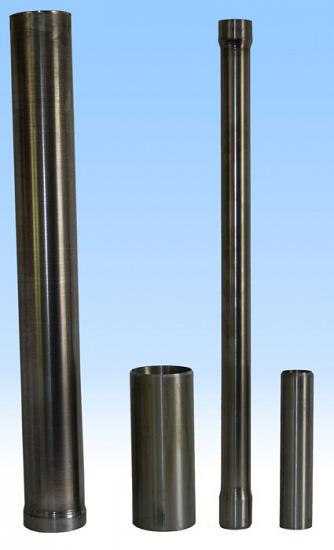
Figure 2
What Is Metal Spinning?
Metal spinning produces axisymmetric workpieces starting from a blank. This blank is commonly a flat disk sheet and occasionally a deep-drawn or machined preform. The blank is clamped against a rotating mandrel using a tailstock system, and the mandrel is shaped with the profile of the inner final workpiece. Once the blank is clamped and rotated, forming slides drive a rotating tool called a roller against the blank. With consecutive movements called strokes or passes, the roller pushes the blank against the mandrel (see Figure 3).
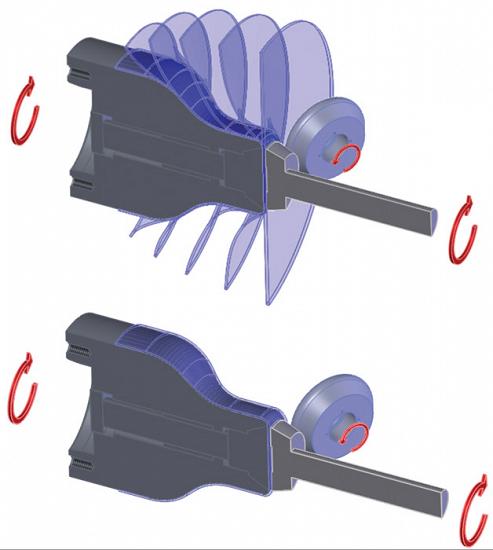
Figure 3
After several backward and forward forming passes, starting next to the mandrel surface to the edge of the disk blank, the material progressively forms closer to the mandrel until the final shape is obtained. A final pass leaves a good finish quality and forms the material tightly to the mandrel to satisfy dimensional and tolerance requirements.
Metal spinning has several iterations that suit different applications. Among them, multipass spinning is the most common; as described earlier, a roller makes forming passes across the spinning disk multiple times, shaping the metal against the mandrel.
Another common iteration, shear forming, finishes a part in just one pass, with the roller pressing against the metal in a unique fashion. In multipass spinning, the unformed flange section of the disk bends forward and backward during the process, depending on the type and direction of the spinning passes. In shear forming, the roller keeps that spinning flange perfectly vertical during the process.
Besides multipass spinning and shear forming is another, less common metal spinning iteration called necking-in or reducing—sometimes referred to as “spinning on air.” As the name implies, it usually requires no mandrel for internal support. It is commonly used for shapes such as gas bottles, which are necked-in out of a tube.
What Is Flow Forming?
Flow forming produces axisymmetric cylindrical workpieces starting from hollowed tubes, pre machined blanks, or forged or deep-drawn parts. The initial part is clamped against the rotating mandrel with a tailstock system. Three forming rollers are distributed equally in a circle, each 120 degrees apart, and can move axially and longitudinally. Once the system rotates, the rollers push against the material in the axial direction all along the length of the preform. Consequently, the material is stretched in this movement direction, thinning the preform wall to keep the initial material volume (see Figure 4).
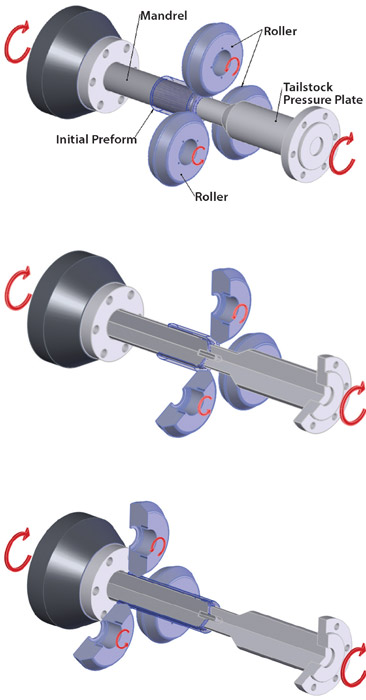
Figure 4
Flow forming typically requires one to three axial strokes, or passes, each one stretching and reducing the wall thickness. The number of strokes depends on different factors, such as the preform initial thickness and final part thickness relationship, material formability, and machine forces. After the flow forming operation is finished, the machine’s extractor system ejects the workpiece.
Although three-roller flow forming machines are still most common, machinery with more than three rollers is also being employed to achieve greater forming forces and production speeds.
Metal spinning excels when the final workpiece geometry has multiple diameters and material thickness reduction is not a major concern. The products manufactured with flow forming are more restricted—mainly to pipes and tubes with highly precise geometries, including their inside diameters and thicknesses.
Flow forming also strengthens the material, which presents some economic advantages. The process starts with thick, short preforms to obtain long, thinner-walled and precise final parts.
Blanks and Preforms
Metal spinning and flow forming have noteworthy differences in the initial blank or preform used, mainly because the final workpiece produced by each process has different requirements. About 90 percent of spun parts can be formed by starting with a blank disk trimmed from standard commercial sheet metal. When starting with a disk blank is not a viable option, normally because the final workpiece has complex shapes or thickness variation, metal spinning can use premachined, forged, or deep-drawn preforms.
Flow forming usually starts with preforms that have been deep-drawn or machined. Just a few flow forming applications can start with commercially available raw material preforms.
Differences in Execution
Metal spinning uses a consecutive number of passes to form the blank. Only in the final stage of those strokes is the material pressed against the mandrel, with the material thickness being controlled. For this reason, it is somewhat difficult for metal spinning to produce a workpiece of uniform thickness throughout the process. Metal spinning uses only one, sometimes two, rollers, and only the roller tips control the workpiece shape and thickness.
In flow forming, three or more rollers apply constant pressure against the material and mandrel throughout each stroke. Using parameters from the CNC, the machine controls the pressure and the workpiece thickness at the forming rollers’ point of contact, all along the stroke. The result: Flow forming can produce a part with a highly accurate, uniform material thickness.
Materials
Some materials in certain conditions can be formed only in warm or hot conditions, with torches, induction heating systems, or ovens heating the material. But for the most part, both metal spinning and flow forming are considered cold forming processes.
Cold working positively affects the workpiece’s mechanical properties, producing improved grain structures and increased tensile strength. How much cold working takes place in the workpiece depends on the wall thickness reduction.
These improved mechanical properties usually are more important in flow forming than in metal spinning, because the amount of wall reduction applied to flow formed parts is much greater. Regardless, the maximum thickness reduction depends on the material and its initial metallurgical conditions; it is not related to the forming process.
Metal spinning and flow forming can be used to form a variety of materials, and some materials are easier to form than others, both from a dimensional and process control perspective. For instance, metal spinning aluminum can be quite easy to control, while flow forming aluminum can be much more complex (see Figure 5).
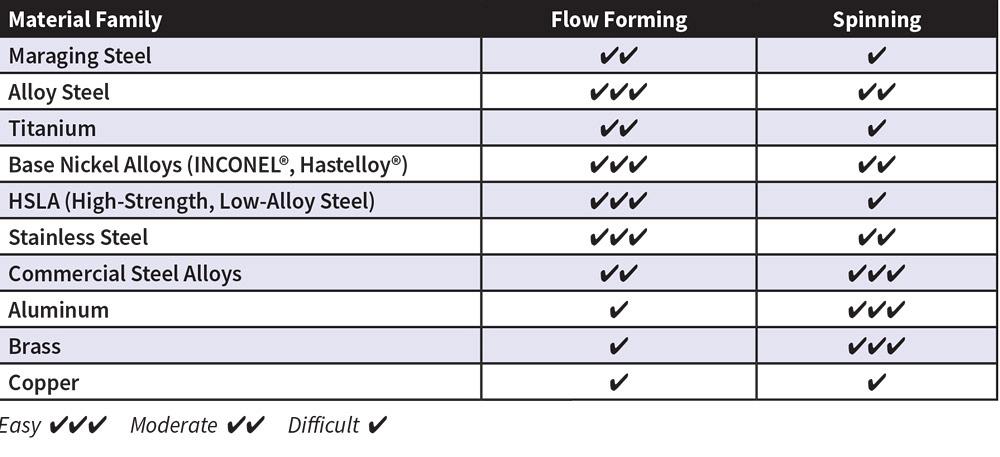
Figure 5
Equipment
Metal spinning lathes (also called spin forming machines) and flow forming lathes have common basic components such as headstocks, tailstocks, and working unit slides.
Flow forming machines are designed and built to be robust enough to handle the high forming forces of the process, including the high forming forces needed when starting with thick blanks (see Figure 6).
Spinning machines are faster because the parts can be produced with high RPMs and feed rates.
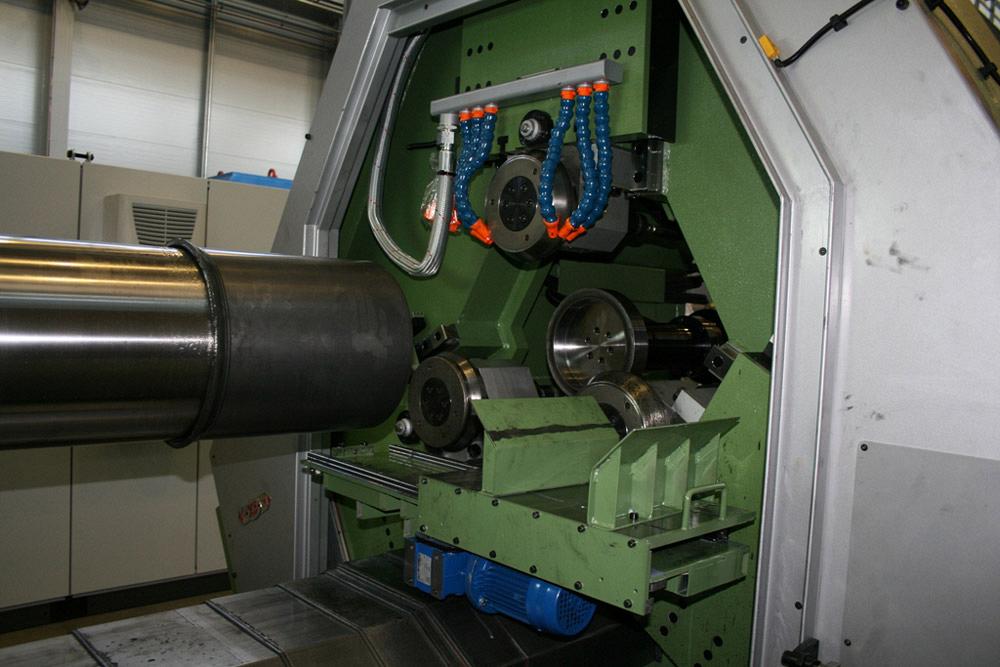
Figure 6
Tooling
The complexity and cost of the tooling depend on the workpiece’s dimensional requirements and material hardness. Flow forming is ideal for manufacturing parts out of high-strength materials; the process’s high forming forces can produce these parts within tight dimensional and thickness tolerances. This requires the design and manufacture of hardened mandrels within tight tolerances, robust enough to produce parts in the thousands.
The materials and final-dimension accuracy produced with metal spinning are generally not as demanding. The mandrels and forming rollers usually can be designed and manufactured economically.
Complementary Processes
Sometimes using both techniques can solve a manufacturing puzzle. For example, some operations use metal spinning to start from a blank disk and manufacture a spun part that, in turn, can be used as a preform for flow forming, which forms the part to its final dimensions.
The exact process depends on the material. Some workpiece materials can go right from metal spinning to flow forming, while other material types require annealing after spinning to make the material formable again for the flow forming process.
Conclusion
Though both processes are very similar, each has important differences regarding the final workpieces they can achieve. Flow forming is the best process when part shapes are cylindrical, have a high length-to-diameter ratio, and dimensional accuracy (inside diameter, outside diameter, and thickness) is important. Metal spinning is a more common and versatile process when high dimensional accuracy is not necessary, especially for highly formable metals.
Which process suits best? That depends, as it always does, on the application requirements.
Sources: thefabricator.com, pmfind.com
